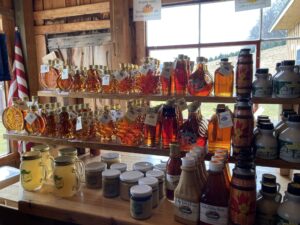





We’ve noted often in the past our preference for using maple syrup instead of sugar when culinary needs require a sweetener. Unlike sugar, a quarter cup of maple syrup supplies 62 percent of your daily riboflavin requirement, about 9 percent of calcium, 8 percent of zinc, and 5 percent of potassium and less maple syrup than sugar is required to sweeten a recipe.
Our personal preference to use maple syrup is also rooted in an economic reason: to spend dollars locally and support local agriculture since my home in upstate New York is in the heart of the only suitable terroir in the world for maple syrup: the geographic triangle running from Michigan to New Brunswick (Canada) to West Virginia.
Further, a recent article in Sierra, the magazine of the Sierra Club, How Maple Syrup Producers Are Protecting Their Product From the Climate, A sweet story of adaptation by Nikki Kolb (4/21/22) provides this important additional reason growing out of the overwhelming concern to slow down global warming:
“While producing maple syrup has its environmental challenges, when it comes to sweeteners, switching from heavily subsidized cane and corn syrup to maple is still one of the most sustainable swaps (emphasis in original) consumers can make to protect vital forests and encourage carbon drawdown.”
As a result, it was wonderful news (albeit somewhat surprising) that according to United States Department of Agriculture (USDA), in 2022, the national production of maple syrup was up 35 percent to 5.03 million gallons from the previous season. The record high maple syrup production in Vermont (the top producing state in the nation) led the way with 2.55 million gallons, up 46% from 2021, according to Pam Hird, state statistician of the USDA’s National Agricultural Statistic Service, New England Field Office.
Part of the reason for the remarkable increase in production in Vermont was due to Vermont maple syrup producers putting out 6.65 million taps in 2022, an increase of 2% from the 2021 total. Plus, the yield per tap in 2022 was estimated to be 0.383 gallon, up from 0.269 gallon from 2021. In addition, the earliest sap flow reported in Vermont (and also in upstate New York) was January 1, 2022, with the season in Vermont lasting 40 days, compared with 28 days in 2021.
We’ve recently touted (once again) when noting the newly opened location of Vermont-based Skinny Pancake in Albany, NY, Vermont’s status as the greenest state in the United States as indisputable. Its production of maple syrup is further evidence: Vermont has led the U.S. in the number of maple taps every year since 1916 and was only out produced, long ago, in 1918 and 1926. Pam Hird, Vermont’s USDA state statistician notes that in 2003, Vermont had 2.12 million taps, steadily increasing to 6.65 million in 2022. Wow.
Production of maple syrup in the 2022 season of the other states in the geographic triangle of North America, with terroir suitable for the production of maple syrup, that follow #1 Vermont in their production of maple syrup in 2022 of 2.55 million gallons are as follows:
#2 New York with 845,000 gallons; #3 Maine with 672,00 gallons, #4 Wisconsin with 440,000 gallons; #5 Michigan with 190,000 gallons; #6 New Hampshire with 167,000 gallons; and #7 Pennsylvania with 164,000 gallons.
Information for maple syrup production in the other states in this geographic North American triangle, i.e., Connecticut, Massachusetts, Rhode Island, Minnesota, Ohio, Indiana, Illinois and West Virginia, was not readily available.
Of course, it should be noted, that like wine, the taste of maple syrup can vary depending on the location of the sugar bush tapped and when in the season the sap flowed from the tapped trees (early in the season verses later in the season).
Rowan Jacobson’s American Terroir, Savoring the Flavors of Our Woods, Waters, and Fields (Bloomsbury USA, New York, NY 2010), has a fascinating chapter on the terroir of maple syrup. Published in 2010, with a paperback version in 2012, copies remain available on-line from various vendors on Amazon. He writes in language that rises to poetry when describing a particular tasting of Vermont maple syrup from “one of the highest sugar bushes in the world at 2100 feet.” This particular syrup contained “the essence of the life force of a single day in a high mountain maple grove.” Quite the appreciation of Mother Nature’s American sweetener!
(Frank W. Barrie, 6/20/22)





